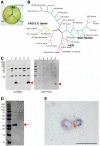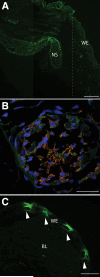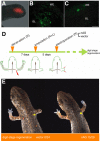Molecular basis for the nerve dependence of limb regeneration in an adult vertebrate
- PMID: 17975060
- PMCID: PMC2696928
- DOI: 10.1126/science.1147710
Molecular basis for the nerve dependence of limb regeneration in an adult vertebrate
Abstract
The limb blastemal cells of an adult salamander regenerate the structures distal to the level of amputation, and the surface protein Prod 1 is a critical determinant of their proximodistal identity. The anterior gradient protein family member nAG is a secreted ligand for Prod 1 and a growth factor for cultured newt blastemal cells. nAG is sequentially expressed after amputation in the regenerating nerve and the wound epidermis-the key tissues of the stem cell niche-and its expression in both locations is abrogated by denervation. The local expression of nAG after electroporation is sufficient to rescue a denervated blastema and regenerate the distal structures. Our analysis brings together the positional identity of the blastema and the classical nerve dependence of limb regeneration.
Figures






Comment in
-
Developmental biology. Acceptable nAGging.Science. 2007 Nov 2;318(5851):754-5. doi: 10.1126/science.1150795. Science. 2007. PMID: 17975053 No abstract available.
References
Publication types
MeSH terms
Substances
Grants and funding
LinkOut - more resources
Full Text Sources
Other Literature Sources
Medical

